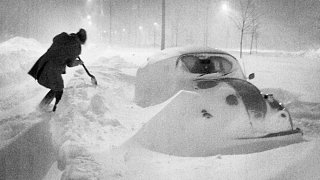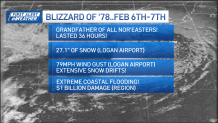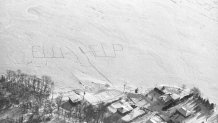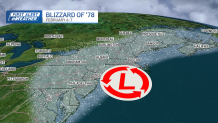
Forty-six years ago, the Blizzard of '78 was exiting New England, concluding 36 hours of aggressive snow, wind and rounds of coastal flooding that left a lasting impact on the region. Beyond its status as a significant snowstorm, the event fundamentally altered the way an entire generation interpreted major snow forecasts.
The storm hit New England on Feb. 6 and Feb. 7, 1978.
Despite receiving advance notice, this forecast came on the heels of a January blizzard that dropped 21" of snow. According to the National Weather Service, this created general fatigue among the public and a wariness of how bad it potentially could get.

Get New England news, weather forecasts and entertainment stories to your inbox. Sign up for NECN newsletters.
Meteorologically, a strong high-pressure system over Canada, an impending high tide, and a rapidly strengthening low-pressure system that eventually parked off the Southern New England coast formed the "perfect storm." The interaction of this system, cold Canadian air, and warm ocean temperatures added fuel to the Nor'easter, giving rise to what is now referred to as the Granddaddy of Nor'easters.

Over 36 hours, the Blizzard of '78 unleashed relentless snow and near-hurricane-force sustained winds along with tides surging 4 feet above normal high tide, accompanied by 12-foot waves on top of that, causing extreme coastal flooding. These factors crippled the region for over a week and left behind chaos across Boston and New England—the tragic loss of 99 lives, abandoned cars numbering over 5,400, and nearly 13,000 damaged homes (11,000 of which from coastal flooding). Stranded individuals exhibited resourcefulness, resorting to creative measures such as carving messages for help in the snow. The total damage incurred amounted to a billion dollars.

Today, the National Weather Service (NWS) has streamlined information distribution, providing the public with various ways to access crucial updates. However, during the Blizzard of '78, the efficiency of information dissemination faced significant challenges. The limited availability of offshore buoy data and a scarcity of wind observation sites, coupled with the destruction of existing ones, impeded the timely gathering of essential data. The warnings issued by the NWS encountered delays in the distribution process, particularly in reaching TV and radio stations for broadcast.
Weather Stories
Advancements in data retrieval and technology for the public to access watches and warnings would make the forecasting and response to this blizzard in today's world much different.



